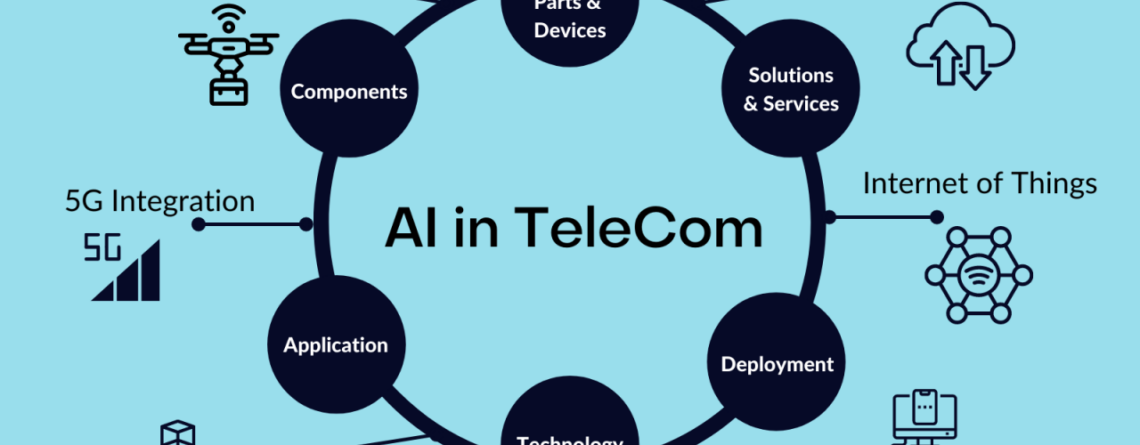AI applications in Telecommunications
AI is transforming the telecommunications industry in numerous ways, enhancing efficiency, customer experience, and overall network performance. Some key applications of AI in telecommunications include:
- Network Optimization and Management
- Predictive Maintenance: AI algorithms analyze network data to predict and prevent equipment failures before they occur. This reduces downtime and improves the reliability of the network.
- Traffic Management: AI can optimize network traffic by dynamically adjusting resources based on real-time data, ensuring that users experience consistent performance, even during periods of high demand.
- Self-Optimizing Networks (SON): AI-driven SON solutions automatically adjust network configurations to enhance performance, reduce congestion, and improve service quality without human intervention.
- Customer Service Automation
- Chatbots and Virtual Assistants: AI-powered chatbots and virtual assistants help customers with billing inquiries, troubleshooting, and general support, providing 24/7 assistance.
- Speech Recognition and Natural Language Processing (NLP): AI uses NLP to process and understand customer interactions in multiple languages, improving customer support through automated voice recognition.
- Sentiment Analysis: AI tools can monitor customer feedback across channels (social media, call centers, etc.) to identify issues early and predict customer sentiment, helping companies improve service quality.
- Fraud Detection and Security
- Fraud Prevention: AI systems analyze network activity to detect unusual patterns that could indicate fraudulent behavior, such as unauthorized calls, SIM card cloning, or identity theft.
- Network Security: AI can continuously monitor network traffic for signs of cyberattacks or security breaches, enabling faster identification and mitigation of potential threats.
- Personalized Marketing and Recommendations
- Customer Behavior Analysis: AI analyzes large volumes of data to understand customer preferences, enabling telecom companies to offer personalized promotions, plans, and services that resonate with specific customer segments.
- Churn Prediction: AI models can predict when customers are likely to leave by analyzing their usage patterns, allowing telecom providers to take proactive measures (e.g., targeted offers or engagement campaigns) to retain them.
- AI in 5G Networks
- Intelligent Resource Allocation: AI helps manage the complexities of 5G networks by predicting traffic demand and optimizing resource allocation for enhanced speed, reliability, and coverage.
- Network Slicing: AI supports dynamic, automated network slicing, which enables telecom providers to allocate specific resources to different applications or customer segments for better service quality.
- Data Analytics and Business Intelligence
- Customer Data Insights: AI systems process vast amounts of customer data, providing actionable insights that help telecom companies understand market trends, identify new business opportunities, and improve decision-making.
- Revenue Assurance: AI helps telecom operators monitor and analyze financial data to detect revenue leaks, billing errors, or other discrepancies that can impact profitability.
- Robotic Process Automation (RPA)
- Automating Back-End Operations: AI-powered robotic process automation (RPA) automates repetitive tasks in billing, provisioning, customer onboarding, and service management, leading to cost savings and improved efficiency.
- Order Fulfillment and Logistics: AI enhances supply chain management by predicting demand for network infrastructure components and automating procurement processes.
- Edge Computing and AI Integration
- Real-Time Decision Making: AI at the edge can process data close to the source, reducing latency and enabling real-time decision-making for applications like autonomous vehicles, IoT, and smart cities.
- Network Traffic Offloading: Edge AI can help optimize data processing by offloading traffic from centralized data centers to local edge devices, improving network performance.
- Voice and Video Analysis
- Enhanced Voice Services: AI enhances voice recognition and natural language understanding, enabling services like voice-activated controls and improved call quality.
- Video Conferencing Improvements: AI can improve video quality by adjusting parameters like resolution and bandwidth in real-time, as well as offering features like background noise reduction or virtual backgrounds.
- Supply Chain and Inventory Management
- Forecasting Demand: AI models can forecast future demand for telecom equipment, components, or services based on historical data and trends, improving supply chain planning and inventory management.
- Logistics Optimization: AI aids in optimizing transportation routes and managing stock levels across warehouses, leading to reduced operational costs and faster delivery of network infrastructure.
Through these applications, AI not only helps telecommunications companies enhance their services but also enables them to stay competitive in an increasingly complex and data-driven market.






